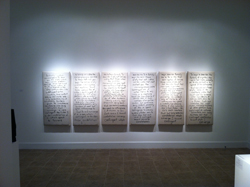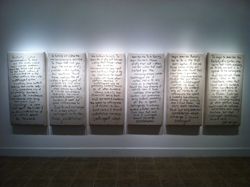Given the Materials at Hand
(2013)
generative sound installation with text on acoustic panels
IMAGES


September - October 2013, Stetson University, Hand Art Center
LISTEN .mp3
excerpt (9'57")
WATCH
NOTES
When a visitor encounters Given the Materials at Hand in a gallery exhibition space, she confronts three elements, each of which interferes with the other two. First, the sound is only coming from behind her as she (visually) attends to the panels and the text painted on them in black. Second, the text appears meaningless (devoid of content), but in consideration of its repetitious presentation/variation across the six panels, suggests pattern (though it is a pattern that is not obvious).* Third, the panels themselves might initially appear as though they are traditional art-objects, perhaps with a canvas surface, while closer inspection reveals that they are not; being made of acoustically absorptive material covered in a thin, breathable fabric, the panels appear to have been intended to oppose the sound.
The panels do not just provide a rectangular surface for the text, they are acoustically absorptive panels, made from 4-inch thick, 8-pound mineral wool. Thus, sound reflections are supressed as the visitor considers the panels. The visitor must choose to turn around to hear more precisely the sonic component of the work, because the sound itself does not appear to emanate from the panels; it is explicitly distinct.
Once a visitor turns away from the panels to face the source of the sound, she will see two speakers (one on either side of the wall that frames a hallway space). Each speaker is placed on gallery pedestals and positioned so the sound is focused towards the center of the space between the panels and the speakers. While in the open space and in front of the panels, a visitor might begin to hear sounds of high-pitched percussive material, some string instruments, and even piano. The sounds might be rather loud, or perhaps soft. They might also be noisy and chaotic, but if the visitor waits in the space for several minutes, they may shift towards a slower regularity. If the visitor moves into another room to consider other work and then comes back, then the sounds might be wholly different, perhaps fast regular repetitions of only a particular piano chord. If the visitor waits again, then the sounds may shift toward slow muted guitar glissandi between nine and ten particular pitches, and then drift off from there. The sound is generated in realtime. When given consideration, it appears to converge upon stasis points and then shift towards seemingly unorganized randomness.
The visitor who returns to a consideration of the text appearing on the panels may seek to identify the pattern governing the repetition of words across the panels. Moving from left to right across the panels, the same words appear in different sequences but syntax does not seem to be more or less preserved in consideration of one panel versus another for the first five panels. In panel six (the last on the right) all of the same words appear, but in an order that is syntactically correct (i.e. readable).
The work as a whole does not seem to be entirely knowable. Rather, as a result of the divergent appearances of the work's various components, visitors encounter their own inability to address it as being whole; the work is perceived as nothing but a series of irreducible gaps between its components. A visitor's inability to know what the work means, its presupposed universal meaning, comes as a result of the visitor's own inability to perceive what it actually is. The absence of universal meaning (a way to know the piece) is thus not a mark of our finitude, but of the ontological incompleteness of the work itself, its being any consistent thing.* The text was generated algorithmically by applying the mathematical permutation that describes the word repetition pattern of a Sestina to sequential sets of six words, and then interlacing the sets according to a different offset factor for each panel. The algorithm is cyclical; when the permutation is applied to panel six (the panel that is semantically intelligible) the text for panel one (first on the left) is produced.